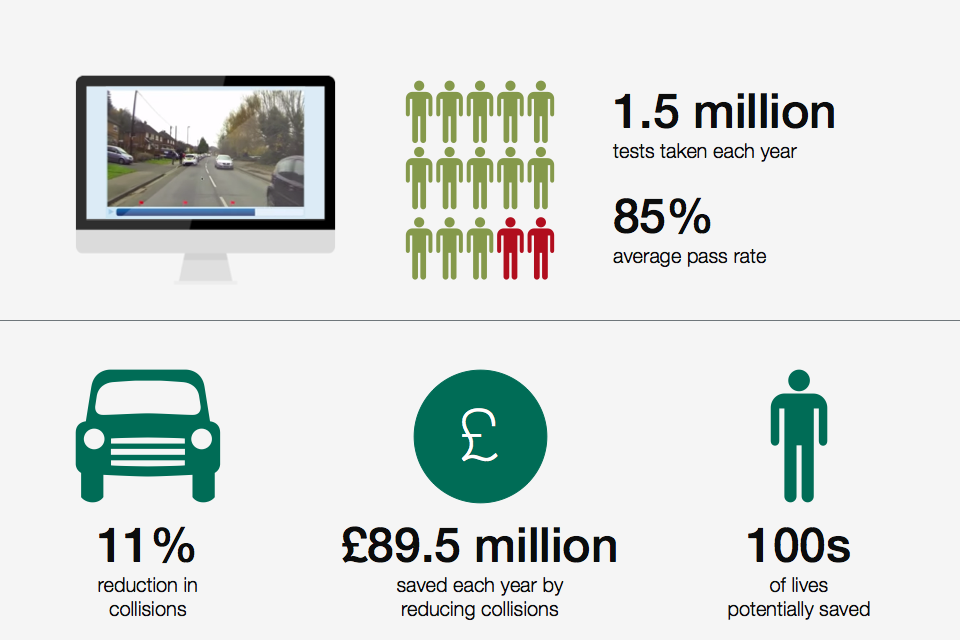
Only the first click within the “scoring zone” will actually score you points, but you will lose nothing for clicking anywhere else in the clip. To put it simply, every time you see something that you think may be a hazard, click the mouse. You are only looking for 1, or possibly 2, hazards in each clip, but there may well be more things in the clip that you perceive to be a hazard. In fact, the number one piece of advice I always give to my own pupils who are preparing for the test is, don’t be scared to click. To pass the hazard perception part of the test you will need to obtain a score of 44 out of 75, and you will need to pass both the questions, and the hazard perception test, at the same time to obtain a pass certificate.Ĭan I only click once per clip then, or will I be disqualified if I click too often?Ībsolutely not. Like in a real driving situation, you never know what is coming next! This is designed so that you keep watching each clip to the end, rather than just deciding you’ve found the hazard in that one clip, and then losing focus.

This means that each clip contains 1 scoring hazard, but 1 clip will contain 2. When sitting your actual test you will watch 14 video clips, and will see 15 hazards across those clips. If it does develop before you’ve reacted, then you will receive no points for that hazard. If you click as soon as a hazard starts to develop, you will score 5 points, this then decreases through 5-4-3-2-1 as you get closer to the hazard. If there is no reaction before that happens, you will score no points for that hazard.Įach hazard has a maximum score of 5 points available. As you get closer still, it may start to edge out, before eventually pulling out in front of you causing you to stop, or swerve. At that point the hazard has started to develop, so clicking now would get you maximum points. As you get closer though, the car may apply a right indicator. As you approach it, it is just parked up, stationary, so at that point, there is no need to click. Points are awarded for reacting to these situations rapidly.
DVLA THEORY AND HAZARD PERCEPTION TEST DRIVER
At some point during the clip a hazard will develop into something that will cause you (or the driver in the clip) to need to take action. All of these would be hazards, but that is not what you are looking for during this test. A parked car, a pedestrian, a sharp bend, a large puddle etc. It is a test designed to gauge your reactions to developing hazards, so, before we go any further, it is vital that you understand what that means.Ī hazard is generally defined as any situation which, could, make you react, by changing speed or direction. It is really important to note that the hazard perception test is not looking for you to spot every single hazard, or potential hazard. This is a skill that is vital to driving in the “real world” and Department of Transport Research suggests that, since the introduction of the hazard perception test, there has been an 11% reduction in accidents amongst new drivers. The idea of the hazard perception test is that a learner driver watches a real life driving situation, and “reads” the road ahead, identifying potential hazards, and reacting to them in good time. Knowing the answers to questions that appear on a screen is one thing, but its important that knowledge can be transferred to help in real life, driving situations. Whilst this is all really useful, it is quite easy to get caught in a trap of viewing the theory test like a paperwork exercise.

The theory test itself is designed to drastically improve a potential driver’s knowledge of things they may encounter whilst driving. What is the point of the hazard perception test? Here, I will try to make it a little clearer, and help you understand what you need to do to pass the hazard perception test with ease.


As with many things in learning to drive, there are a lot of myths and fallacies attached to the hazard perception. Worse still, when pupil’s fail on the hazard perception, it very often becomes clear they didn’t really understand what they were looking for, or how the scoring works. Almost all of the revision material available, be it websites, apps or CD-ROMs, contains practice clips, but most contain very little explanation of how the hazard perception element of the test actually works. Some 16 years on though we still find that many people who are preparing for the theory test don’t really understand how it works. The theory test was first introduced back in 1996, and the hazard perception element was added in November 2002.


 0 kommentar(er)
0 kommentar(er)
